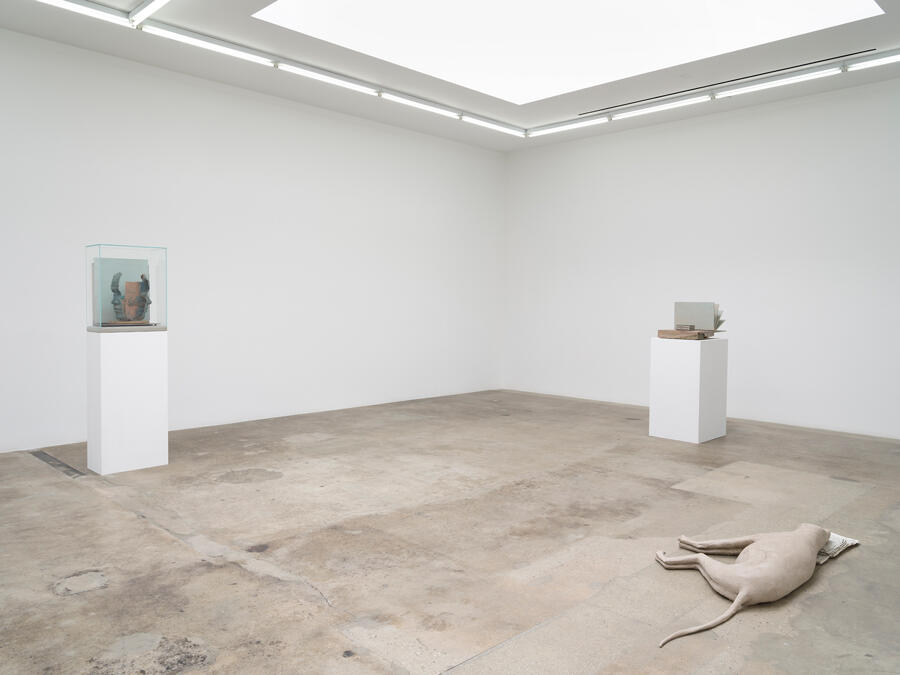Mark Manders’s Disappearing Act
At Tanya Bonakdar, Los Angeles, the artist presents sculptures and installations that revel in the magic past the limits of language
At Tanya Bonakdar, Los Angeles, the artist presents sculptures and installations that revel in the magic past the limits of language

Call me a cynic, but it’s a rare experience to fall under art’s spell. Last month, however, I watched Ethan Sklar, director of Tanya Bonakdar Gallery, perform a trick of prestidigitation while touring me around Mark Manders’s show ‘Writing Skiapod’. By stepping on the exhibition catalogue, he turned its colour images greyscale; repeating this act in a different part of the gallery, he made the illustrations and text disappear. A third time, and the book was back to normal: a syllabus of historical artworks and writing (much of it faked) about the skiapod, a dwarf-like creature from Greco-Roman mythology with a single, gigantic foot aimed at the sky. His only hint as to how he completed the trick was that the inconspicuous concrete floor (not for sale) was the most expensive thing on display.

Like Oedipus solving the Sphinx’s riddle, we need to follow a few deductive steps here, which Manders helpfully lays out for us on a page mounted to the gallery’s foyer wall. Number one: ‘Create a room filled with all existing words.’ Most of the nine new sculptures on view contain expressions from Manders’s ‘Notional Newspapers’ (2005–22), a recently completed series of broadsides printed with every word in the English language. Reproduced out of order, they read like surrealist nonsense poetry: ‘Homered highhanded-nesses “sublanguage” bulk’, blares one headline (Composition with Two Colours, 2005–22). You might think of Manders’s lexical collection as a dictionary, but it’s one the artist has scrambled so that we can’t find our way.

A full set of these newspapers hangs from clothes lines in the exhibition’s central installation, where the overhead lights have been cut in favour of two whirring slide projectors. They fulfil Manders’s second and third steps: ‘Choose one single word that is hardly used. A word that is linked to a failed myth’ – a tale that never caught on, perhaps because it fell short of its function to justify cultural tradition or natural phenomena. – and ‘Expand the myth by creating fake images with a fake history.’ Which of these skiapods – depicted in the style of a 15th century European woodcut and projected on the wall – is real, and which is not? Did Brazilian modernist Tarsila do Amaral really paint the mythical monoped? The catalogue can’t be relied upon to tell us the whole truth, if it can tell us anything at all – nor can the ‘Wipipekia’ page Manders has made, linked on the gallery website, full of real and bogus citations.

It’s unclear why the artist chose the skiapod as his muse, but don’t ask too many questions: as with his newspapers, we’re forced literally to take him at his word. Manders gathers up language only to revel in its inadequacies: when it fails to explain something, we often resort to art or mysticism. The mute, slivered faces that appear in several sculptures, such as Night Scene (2020–22) – the medium for which Manders is best known – refuse to provide any answers. Even their cracked skin, which resembles clay, is mostly made of patinated and painted bronze – once again, nothing is quite what it seems here.

In the face of art’s increasing didacticism – a response to a culture of virtue-signalling that insists on making intentions plain – Manders instead pulls a sleight of hand. His Room with All Existing Words / How the Body Says Skiapod (2005–22) reminds me of Aby Warburg’s Mnemosyne Atlas (1927), an attempt to classify all the images in Western culture. These efforts are most interesting for their inevitable lack of success. It’s only by chafing at the limits of what’s possible that any of us will have cause to believe in magic.
‘Mark Manders: Writing Skiapod’ is on view at Tanya Bonakdar, Los Angeles, until 8 April.
Main image: Mark Manders, Cloud Study (with All Existing Words), 2005-22, offset print and acrylic on paper, chicken wire, wood, 71 × 51 × 4 cm. Courtesy: the artist and Tanya Bonakdar Gallery, New York / Los Angeles
























